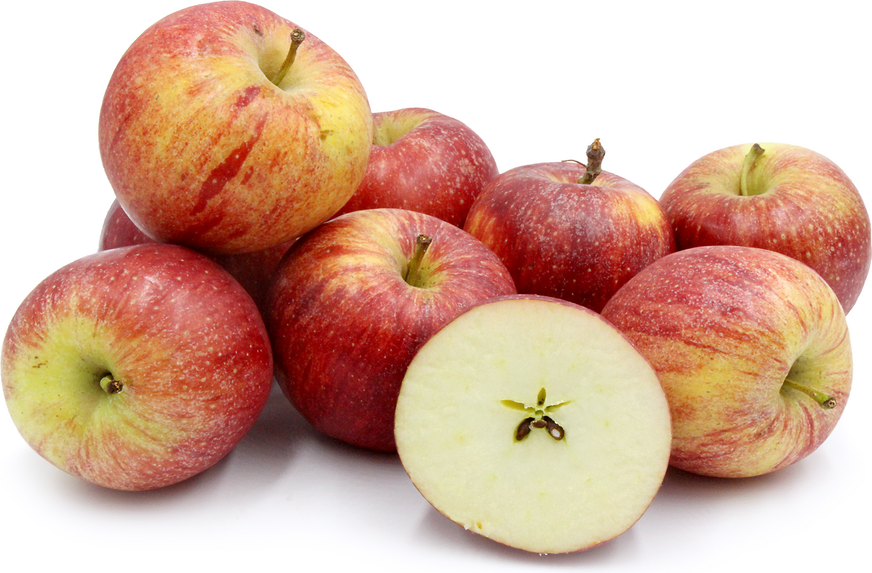


Grapple® Apples
Estimated Inventory, 48 ct : 0
Description/Taste
Grapple® apples vary in size, appearance, and shape, depending on the specific variety, and average 5 to 8 centimeters in diameter with a round, conical, to oblate shape. The apple’s skin is thin to semi-thick, smooth, taut, and sometimes waxy, showcasing prominent lenticels. The skin ripens to shades of yellow-orange and yellow-green, enveloped in patches of dark red striping, blush, and mottling. Underneath the surface, the ivory-to-white flesh is firm, dense, aqueous, and fine-grained with a tender, snap-like, crisp consistency. The flesh also encases a central fibrous core filled with dark brown-black, tiny seeds. Grapple® apples release a robust grape aroma and are edible raw, known for bearing a mild, sweet-tart, floral, fruity, and subtly acidic taste with notable concord grape nuances.
Seasons/Availability
Grapple® apples are no longer in production.
Current Facts
Grapple® apples, botanically classified as Malus domestica, are flavor-infused fruits belonging to the Rosaceae family. The specialty fruits are a branded line of apples that have undergone a patented process to infuse grape flavoring into the flesh. Grapple® apples are either Gala or Fuji apples, as these two varieties have been proven in research to absorb the accompanying grape flavoring the most for an enhanced eating experience. It is important to note that Grapple® apples are not their own variety but are a novelty fruit created by bathing them in a water and food-grade grape flavoring. The art of creating Grapple® apples is a patented process, and once the apples have been bathed in the proprietary mixture, they are dried and kept in cold storage to allow the flavor to penetrate the flesh. This process creates a premium apple that tastes like a mix between a concord grape and an apple but maintains the same nutritional properties of other apples without added sugars or genetic modification. Grapple® apples were once commercially cultivated in Washington and were marketed as a healthy snack and novel consumer good. Since their release in the early 21st century, the company responsible for Grapple® apples has stopped production, and the line of apples is no longer produced for commercial markets.
Nutritional Value
Grapple® apples are a source of vitamin C to strengthen the immune system, fiber to regulate the digestive tract, iron to develop the protein hemoglobin for oxygen transport through the bloodstream, calcium to build bones and teeth, and vitamin A to maintain healthy organ functioning. The apples also provide potassium to balance fluid levels within the body, vitamin E to protect the cells against free radical damage, magnesium to control nerve functions, and other nutrients, including folate, copper, zinc, vitamin K, and boron.
Applications
Grapple® apples have a sweet, tart, and fruity taste suited for fresh and cooked preparations. The apples should be washed before use and their grape flavoring will not be removed with washing. The flavoring has been infused into the entire flesh of the apple, so washing will not disrupt this taste. The apple’s flavor is showcased when consumed straight, out-of-hand. The apples can be eaten as a stand-alone snack, served with cheeses, other fruits, and dips on appetizer plates, sliced into green salads, or layered into sandwiches and quesadillas. Grapple® apples will also retain some flavor when cooked and can be baked into tarts, pancakes, and pies, roasted as a dessert, or dried for extended use. Grapple® apples pair well with honey, chocolate, peanut butter, spices such as nutmeg, cloves, and cinnamon, dried fruit such as raisins or cranberries, and roasted nuts including peanuts, almonds, and walnuts. The fresh apples will last up to one month when stored at room temperature and 2 to 4 months when stored in cold storage.
Ethnic/Cultural Info
Grapple® apples were given their distinct grape taste by infusing them with an artificial flavoring known as methyl anthranilate. This grape essence is non-toxic and considered a safe food-grade solution. Methyl anthranilate was once used as a natural spray to deter birds from stealing fruits from orchards. This scent was said to repel birds for up to ten days, protecting fruit harvests. Grapple® apples were heavily marketed as a children’s snack alternative to candy. According to the Grapple® apple website, grape flavoring, or methyl anthranilate, was FDA and USDA-approved and used in many other food and beverages, including Kool-Aid, juices, soda, chewing gum, and popsicles. It has also been reported that the flavoring was found in many common medicines and is used for its fragrance in lotions, cosmetics, and perfumes.
Geography/History
Grapple® apples are no longer commercially available. The brand was developed by Todd Synder, President of Grapple® Fruits LLC and C&O Nursery in Wenatchee, Washington State. Washington fuji apples and gala apples were used to make Grapple® apples, and both varieties had highly permeable skin and quickly took on the grape flavor. The apples were historically scanned to test for Brix, or sugar levels, using infrared cameras, selecting only the sweetest apples. The apples were also checked for size, color, and quality and were then infused with the artificial grape flavor. Once bathed in the grape flavoring, the apples were moved to cold storage, where they further absorbed their grape flavor. Grapple® apples were released to commercial markets in 2011 and were made exclusively by C&O Nursery. The apples were later distributed in custom packaging to specialty grocers throughout the United States and Canada. In 2016, the company launched a new line of tart Grapple® apples, but a few years later, production stopped for both types of Grapple® apples.
Recipe Ideas
Recipes that include Grapple® Apples. One
| Barbeque Master |
|
Grilled Grapples |
| Cooking Dangerously |
|
Grapple Cake in a Brown Sugar Glaze |
| Martha Stewart |
|
Roasted Winter Squash Soup |
| Food 52 |
|
Cran-Grapple Compote |




